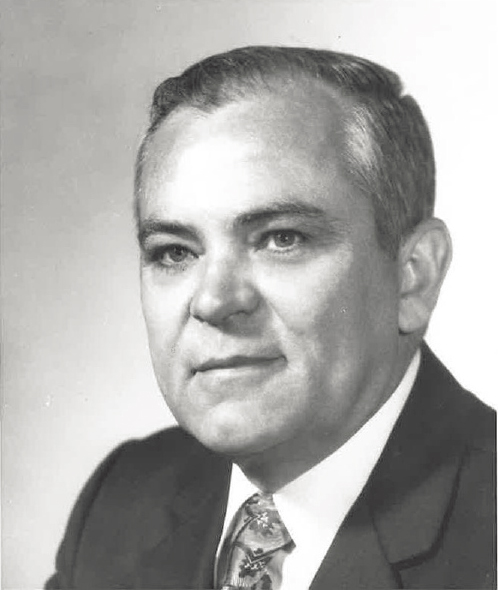JOHN E. DOLAN
1923–2018
Elected in 1980
“Engineering, innovating, and constructing technically advanced facilities in generation, transmission, and distribution for a major US privately owned electric system.”
BY JAMES J. MARKOWSKY
JOHN EDWARD DOLAN, a leader in the development and construction of technically advanced facilities in generation, transmission, and distribution of the largest privately owned electric system in the United States, died March 17, 2018, at the age of 94.
John was born May 9, 1923, in Woodside, a neighborhood of Queens, New York. A devout Catholic, he graduated from Bishop Laughlin High School, enlisted in the Army in 1942, and was quickly selected for officer training and the Air Corps. First Lieutenant John Dolan was awarded multiple air medals for service in World War II as a B-17 pilot, completing 24 combat missions in the European theater with the 8th Air Force.
After the war he went to Columbia University on the GI bill and graduated in 1950 with a BS with highest honors in mechanical engineering; he also received the university’s Illig Medal, awarded by the faculty to a member of the graduating class for commendable proficiency in his or her regular studies.
He joined American Electric Power (AEP) Service Corporation in 1950 as a junior engineer and, after a distinguished career, retired in 1988 as vice chair of engineering and construction. His early work involved the development of
the industry’s first commercial nuclear power plant, Dresden Plant Unit 1 in Illinois. He also served as project manager on a 150 megawatt gas-cooled nuclear reactor study in Florida, and worked with Philip Sporn (NAE 1965, NAS 1962), AEP’s president (1947–61), on a water desalination project in Israel. The Israeli activities involved the design of a 6000 kilowatt plant and a 1,000,000-gallon-a-day seawater conversion unit.
He rose to become head of the Design Division in 1961 and chief mechanical engineer in 1966. He was elected vice president and chief engineer the following year and in short order rose through a number of positions of increasing responsibility before being named director of the parent American Electric Power Company in 1981.
Throughout his tenure at AEP John had significant responsibilities for, made major contributions to, or directed the engineering, design, and construction of 58 generating units totaling more than 25,000 megawatts of capacity as well as the development and installation of over 2000 miles of 765,000 volt transmission lines. Following are some of the major projects on his watch:
- 31 fossil units of 200,000–600,000 kW and five supercritical double reheat 800,000 kW units that were the largest in the world at the time;
- two 1100 MW nuclear units;
- the first major combination pump-storage and run-of-river hydro project; and
- seven 1300 MW units, the world’s largest, including one involved in the unprecedented conversion from nuclear to coal-fired operation.
With John Tillinghast (NAE 1974), he continued and expanded on AEP’s philosophy of the series concept of building units to meet system load in the most economical fashion. Dolan was responsible for development of the integration of single steam turbine–driven feed pumps in large generation units, and for the sliding steam pressure concept (for which he received a patent) and its application on supercritical pressure
generation units, allowing them to maintain a higher generating efficiency at part load, resulting in major fuel and cost savings. The succession from 600,000 kW to 800,000 kW and finally 1300 MW represented the most advanced technology and largest available units at the time.
Late in John’s career at AEP, defects were found in the nuclear steam supply system and containment structure of the nearly completed, jointly owned 800 MW William H. Zimmer Nuclear Power Plant. Correction of the problems would have required the owners to spend substantial sums to redesign, rework, and modify the plant, with no assurance of full compliance with the nuclear regulations or of approval for commercial operation. Because an attempt to correct the deficiencies was thus a very high financial risk, John and his engineers explored alternatives. The breakthrough alternative that John presented to AEP chair Willis S. (Pete) White Jr. (NAE 1983) was to convert the unfinished nuclear plant to a 1300 MW coal-fired power plant. The conversion—made possible by the existing turbine generation and the fact that the low end of the cycle was the same as a 1300 MW unit—was completed on time and within budget.
John wrote numerous publications on the technologies whose development he led for use in large power generating units, and chaired committees for the Association of Edison Illuminating Companies, East Central Nuclear Group, and Edison Electric Institute.
He was made a fellow of the American Society of Mechanical Engineers (ASME) in 1974 and elected to the NAE in 1980. He received ASME’s Outstanding Leadership Award (1979); Nadai Medal (1984), which recognizes significant contributions and outstanding achievements that broaden the field of materials engineering; and James N. Landis Medal (1990), which is presented for outstanding personal performance in the design, construction, or management of major steam-electric stations using nuclear or fossil fuels. AEP honored him by naming a state-of-the-art engineering laboratory after him, the John E. Dolan Engineering Laboratory, which began operation in the summer of 1987.
Upon retirement in 1988, John and his wife moved to Largo, Florida, where they spent many happy years with family and friends.
His wife of nearly 66 years, Anne Margaret (née Youngberg, from his hometown) predeceased John in January 2018. They are survived by seven of their eight sons: Bryan (Joyce), Vincent (Lorene), Robert (Paige), Raymond (Virginia), Philip, Lawrence (Allison), and Paul (Janis), along with 18 grandchildren and 7 great-grandchildren. Sadly their eldest son John (Cathy) predeceased his parents.







